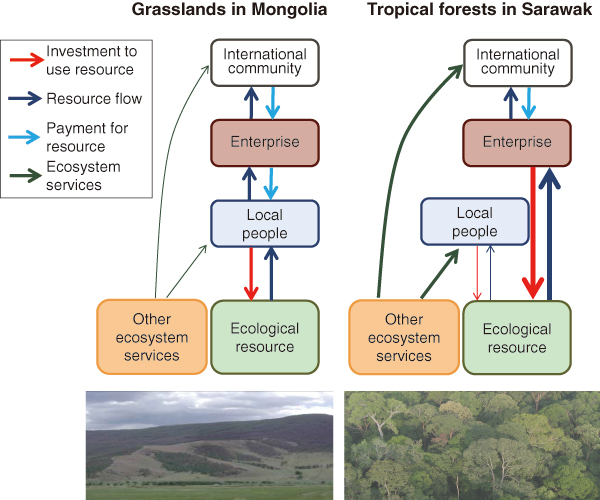Collapse and Restoration of Ecosystem Networks with Human Activity
- D-04
- CR①
- CR②
2014
Most ecosystems on the planet have been seriously degraded by human activities and are now in critical condition. We still do not have a clear perspective on solving these problems, however, owing to the complexity of ecosystems and human societies and their interactions (what we refer to as the Ecosystem Network). The goals of this project are to promote understanding of the environmental problems associated with managing ecological resources and to contribute to their solution using the concept of the Ecosystem Network.
In this project, we address two tangible environmental problems under contrasting ecological settings: grasslands in Central Asia (Mongolia), and tropical rainforests in Southeast Asia (Sarawak, Malaysia). In Mongolia, we focus on the degradation of pastures. For thousands of years, many people in Mongolia have lived by nomadic herding on the grasslands. In recent decades, however, the number of livestock—especially goats for the export of cashmere— has increased rapidly, causing degradation of pastures and hindering sustainable nomadism.
In Sarawak, we focus on the loss and degradation of forests. Local ecosystems have undergone dramatic changes during the last 100 years: land use has shifted from small-scale agriculture by indigenous people to logging of natural forests as a source of timber for export, and then to the development of oil-palm plantations. The expansion of these plantations has brought about a sharp decline in biodiversity and ecosystem components essential to indigenous people.
Research in both Sarawak and Mongolia is comprised of three core stages:

Ecosystem networks of Mongolia and Sarawak simplified for comparison. Mongolian herders use pastures to feed livestock, and their products are sold to the market through companies and enterprises. In Sarawak, timber is harvested and palm oil is produced directly by enterprises. IEcosystem services provided by tropical forests are more highly valued by international markets than those of grasslands are.
- 1) Identification of Ecosystem Network structures underlying the problems. We first propose hypothetical ecosystem network structures and then confirm and evaluate these links through field surveys, remote sensing, literature surveys, and modeling. This stage will provide insight into the factors that cause and accelerate environmental problems and the barriers to their resolution;
- (2) Scenario analyses. We construct multiple scenarios for each case study and estimate land cover and network structures for each scenario based on the results obtained from (1). We then evaluate the predicted ecosystem and social status using various indices;
- (3) Implications for ecosystem conservation from the ecosystem network perspective. By comparing the case studies of Mongolia and Sarawak, we correlate the ecological characteristics of the ecosystems or ecological resources with the structure of the ecosystem network and the associated environmental problems.
We identified differences between the Ecosystem Networks in Mongolia and Sarawak, which stem from different ecological characteristics of the ecosystems and ecological resources. Because of these differences, the appropriate policies and institutions would also differ. In Mongolia, there is potential for sustainable management via a negative feedback mechanism to suppress the overuse of pastures, since the degradation of ecological resources and other ecosystem services directly affects the users. For sustainable management, it is therefore essential to identify factors that weaken feedback mechanisms and to implement policies and institutions that enhance such feedback. In contrast, feedback does not act to suppress overuse in Sarawak, where the main users are enterprises. In this case, sustainable management requires policies to introduce feedbacks or restrict the intensity of resource use.
The results of the project showed that network structures that are likely to lead to environmental problems or ecosystem network restoration depend on the ecological characteristics of the specific system and resources.
▲PAGE TOP